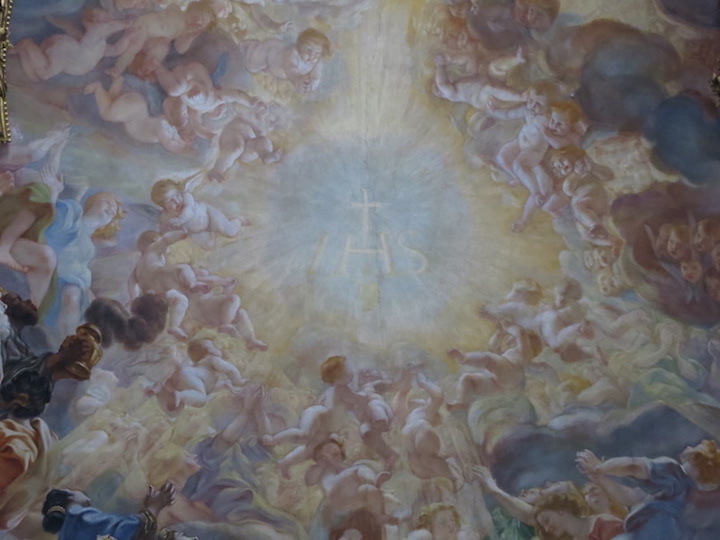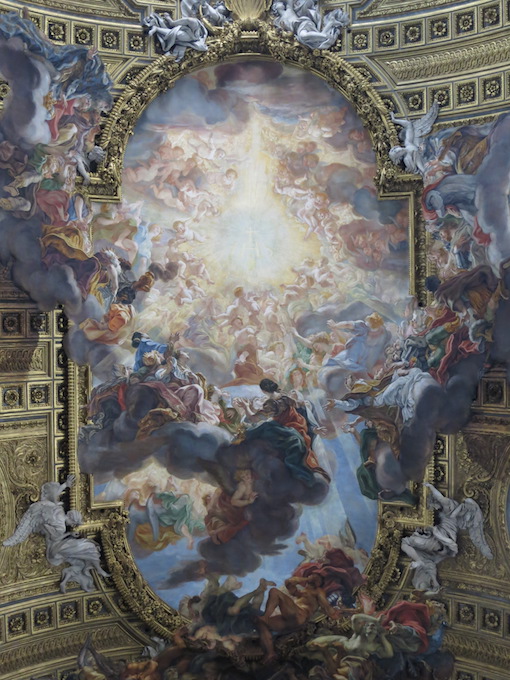Home » Conferences » Christopher Johns Presents Paper at Symposium Focused on the Art of the Gesù
Christopher Johns Presents Paper at Symposium Focused on the Art of the Gesù
Posted by vrcvanderbilt on Monday, April 9, 2018 in Conferences, Events, HART, Lectures, News, VRC.
 Christopher Johns, Norman L and Roselea J. Goldberg Professor of History of Art, delivered a paper, “Giovanni Battista Gaulli and the ‘Adoration of the Most Holy Name’: Painting and Piety in Late Baroque Rome,” at a symposium April 5-6 hosted by the Fairfield University Art Museum and held in conjunction with the current exhibition THE HOLY NAME Art of the Gesù: Bernini and his Age.
Christopher Johns, Norman L and Roselea J. Goldberg Professor of History of Art, delivered a paper, “Giovanni Battista Gaulli and the ‘Adoration of the Most Holy Name’: Painting and Piety in Late Baroque Rome,” at a symposium April 5-6 hosted by the Fairfield University Art Museum and held in conjunction with the current exhibition THE HOLY NAME Art of the Gesù: Bernini and his Age.
Johns’ paper considered the profoundly impressive ceiling fresco by Giovanni Battista Gaulli on the vault of the mother church of the Society of Jesus in Rome, Il Gesù, in the context of late Baroque mysticism and the Ecclesia Triumphans of the Catholic Reformation. As a celebration of visionary mysticism and a visualization of the Jesuits’ struggle against heresy, The Triumph of the Most Holy Name is the first colossally-scaled celebration of the exalted status of the Order in the Catholic Church of the seventeenth century. It exercised enormous influence on Jesuit art patronage, not only in Italy and elsewhere in Europe, but also globally in the context of the missions.
“Today, the splendid fresco has become emblematic of late Baroque mystical imagery in Roman ceiling painting before the dawn of Catholic enlightenment and Neoclassicism,” said Johns, a member of the planning committee for the landmark exhibition featuring artistic treasures from the Roman church of the Gesù never before seen in America.
Organized to commemorate Fairfield University’s 75th anniversary, the exhibition (on view through May 19) features Bernini’s bust of Roberto Bellarmino (patron saint of Fairfield University), Gaulli’s monumental painted wood model of the apse, a gilt bronze altar sculpture by the versatile painter, draftsman and sculptor Ciro Ferri, the sumptuous jeweled cartegloria from the altar of Saint Ignatius, and the magnificent embroidered chasuble of the church’s great benefactor, Cardinal Alessandro Farnese. These masterpieces are joined by more than fifty paintings, sculptures, rare books, precious objects, drawings, prints, and historical documents by Bernini, Domenichino, Gaulli, Ciro Ferri, Carlo Maratti, and Andrea Pozzo, among other Italian Baroque masters, on loan from American museums and private collections.
Johns co-edited the catalogue (Saint Joseph’s University Press, Philadelphia), with Linda Wolk-Simon, director and chief curator of the Fairfield University Art Museum, who described it as “the most important and substantial study in any language devoted to the Gesù.” Richly illustrated with 246 color images, the catalogue is comprised of thirteen essays by an international team of specialists in Italian Baroque sacred art and religious culture followed by a checklist of the works of art in the exhibition. Johns contributed an essay entitled “The Fortunes of the Society of Jesus: Ecclesia Triumphans to Dominus Ac Redemptor.”
The objects in the exhibition were selected for “their artistic and historical significance and their relationship to the Jesuits and the Gesù during their joint first century,” wrote Wolk-Simon, “but the converging narrative threads cannot be explored by objects alone. The essays in this volume by a roster of distinguished scholars give authoritative weight, nuance, and substance to the exhibition’s rich panoply of themes, exploring in depth the constellation of personalities, politics, ideas and faith that gave rise to the Society and its mother church.”
*Giovanni Battista Gaulli, The Adoration of the Most Holy Name, and detail, IHS Christogram, 1676-1679. Rome, Church of the Gesù. Photographs: courtesy Prof. Sheri F. Shaneyfelt, Vanderbilt’s History of Art Department

©2026 Vanderbilt University ·
Site Development: University Web Communications